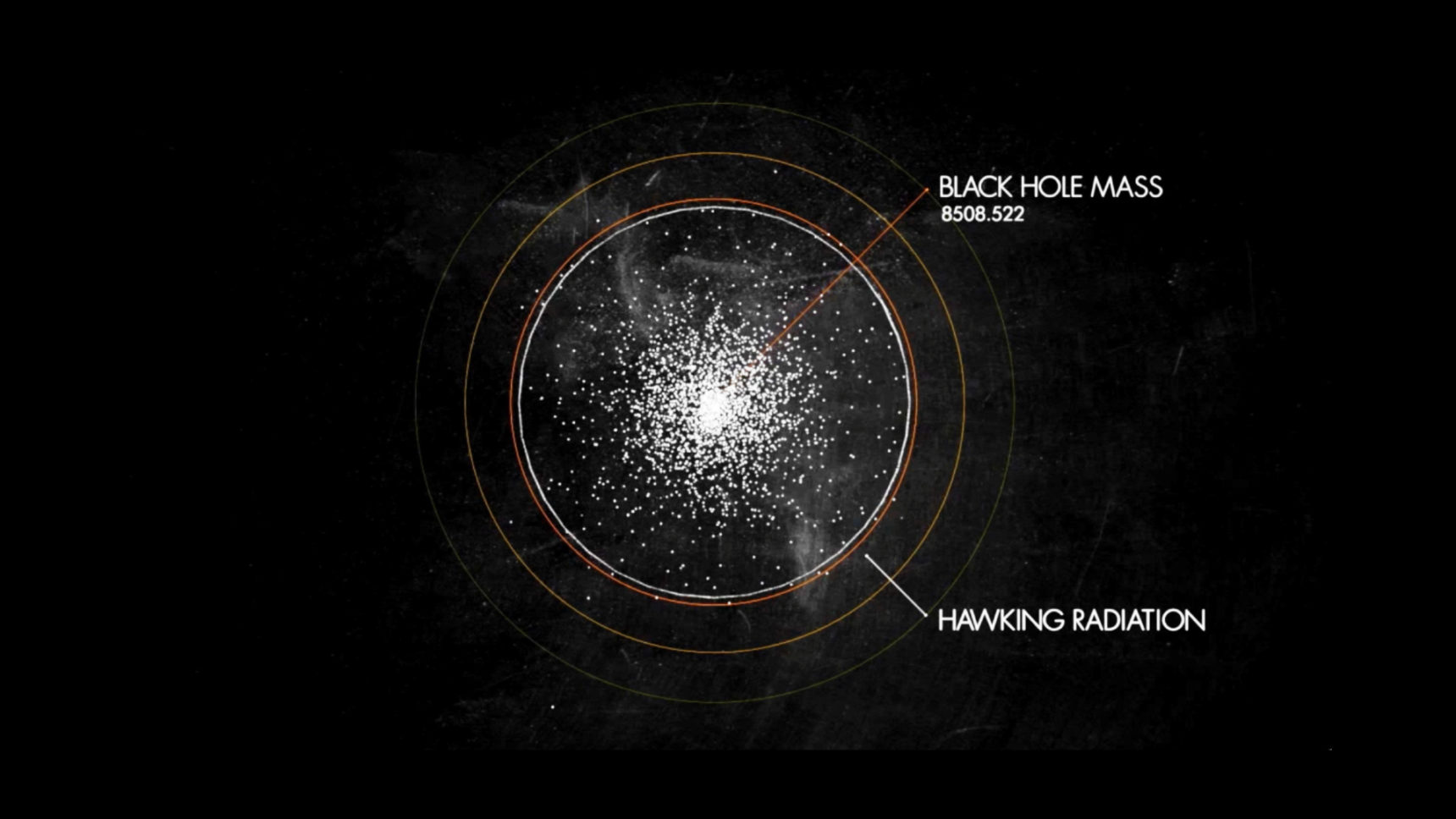Newfound Wormhole Allows Information to Escape Black Holes
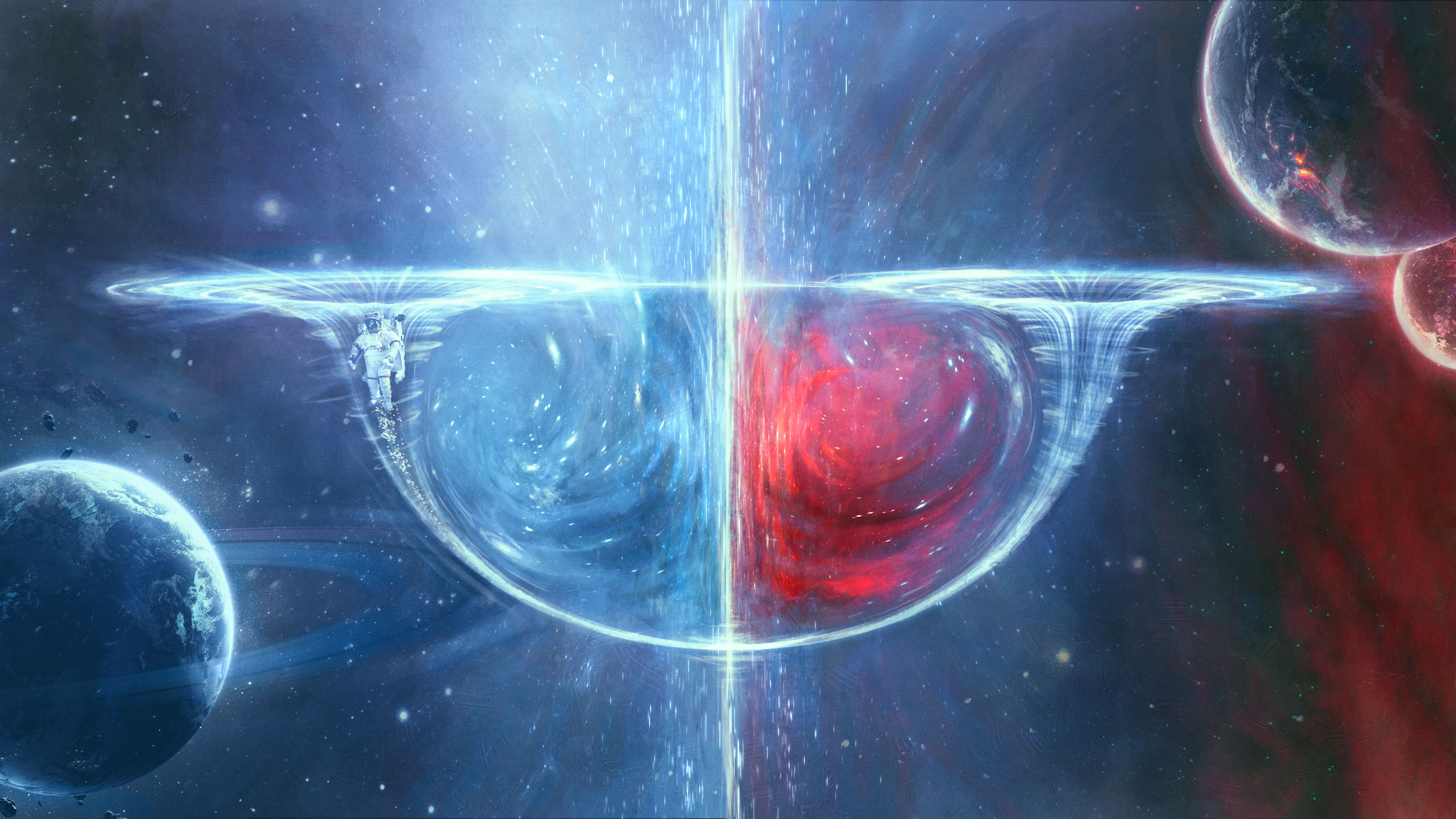
Tomáš Müller for Quanta Magazine
Introduction
In 1985, when Carl Sagan was writing the novel Contact, he needed to quickly transport his protagonist Dr. Ellie Arroway from Earth to the star Vega. He had her enter a black hole and exit light-years away, but he didn’t know if this made any sense. The Cornell University astrophysicist and television star consulted his friend Kip Thorne, a black hole expert at the California Institute of Technology (who won a Nobel Prize earlier this month). Thorne knew that Arroway couldn’t get to Vega via a black hole, which is thought to trap and destroy anything that falls in. But it occurred to him that she might make use of another kind of hole consistent with Albert Einstein’s general theory of relativity: a tunnel or “wormhole” connecting distant locations in space-time.
While the simplest theoretical wormholes immediately collapse and disappear before anything can get through, Thorne wondered whether it might be possible for an “infinitely advanced” sci-fi civilization to stabilize a wormhole long enough for something or someone to traverse it. He figured out that such a civilization could in fact line the throat of a wormhole with “exotic material” that counteracts its tendency to collapse. The material would possess negative energy, which would deflect radiation and repulse space-time apart from itself. Sagan used the trick in Contact, attributing the invention of the exotic material to an earlier, lost civilization to avoid getting into particulars. Meanwhile, those particulars enthralled Thorne, his students and many other physicists, who spent years exploring traversable wormholes and their theoretical implications. They discovered that these wormholes can serve as time machines, invoking time-travel paradoxes — evidence that exotic material is forbidden in nature.
Now, decades later, a new species of traversable wormhole has emerged, free of exotic material and full of potential for helping physicists resolve a baffling paradox about black holes. This paradox is the very problem that plagued the early draft of Contact and led Thorne to contemplate traversable wormholes in the first place; namely, that things that fall into black holes seem to vanish without a trace. This total erasure of information breaks the rules of quantum mechanics, and it so puzzles experts that in recent years, some have argued that black hole interiors don’t really exist — that space and time strangely end at their horizons.
The flurry of findings started last year with a paper that reported the first traversable wormhole that doesn’t require the insertion of exotic material to stay open. Instead, according to Ping Gao and Daniel Jafferis of Harvard University and Aron Wall of Stanford University, the repulsive negative energy in the wormhole’s throat can be generated from the outside by a special quantum connection between the pair of black holes that form the wormhole’s two mouths. When the black holes are connected in the right way, something tossed into one will shimmy along the wormhole and, following certain events in the outside universe, exit the second. Remarkably, Gao, Jafferis and Wall noticed that their scenario is mathematically equivalent to a process called quantum teleportation, which is key to quantum cryptography and can be demonstrated in laboratory experiments.
John Preskill, a black hole and quantum gravity expert at Caltech, says the new traversable wormhole comes as a surprise, with implications for the black hole information paradox and black hole interiors. “What I really like,” he said, “is that an observer can enter the black hole and then escape to tell about what she saw.” This suggests that black hole interiors really exist, he explained, and that what goes in must come out.
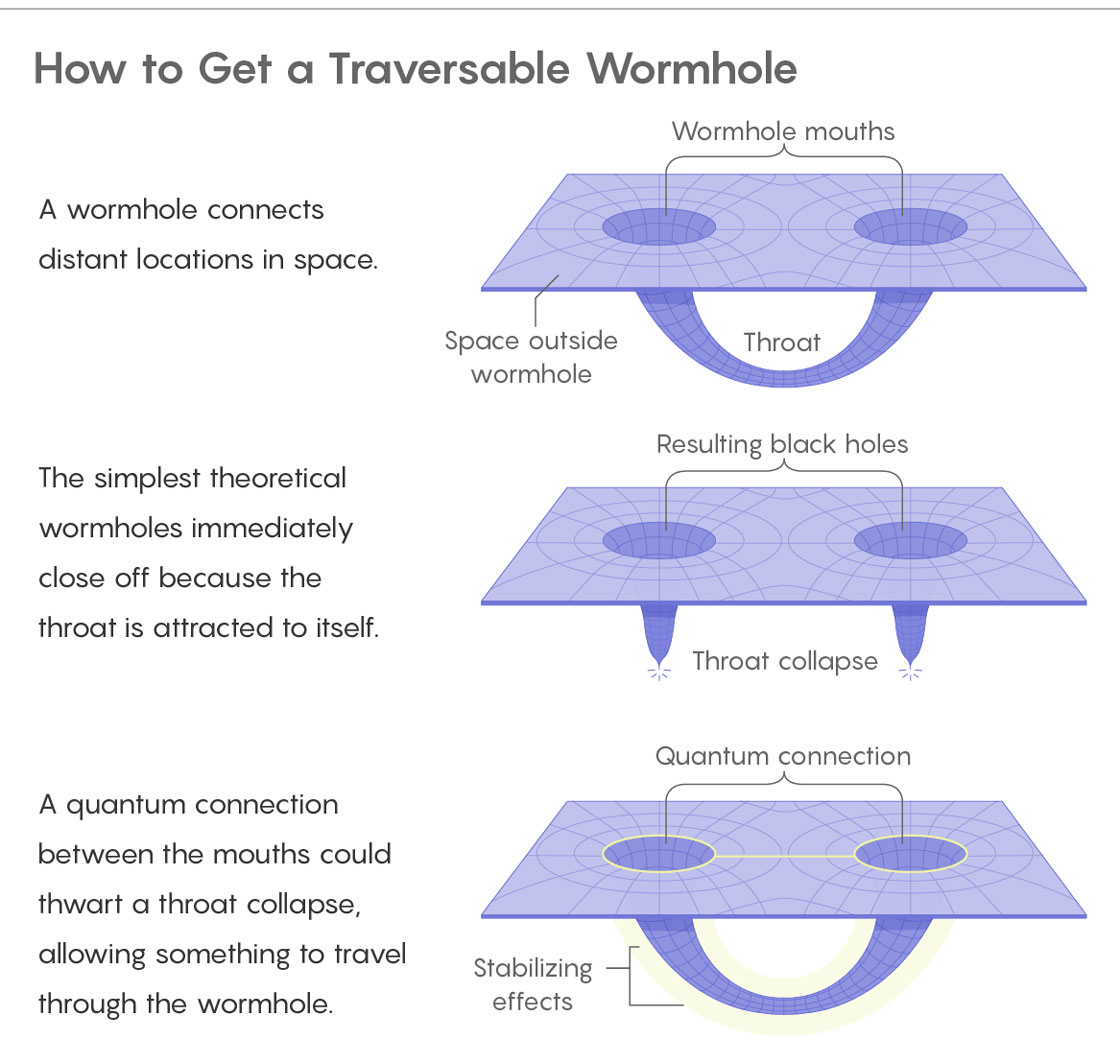
Lucy Reading-Ikkanda/Quanta Magazine
A Cryptic Equation
The new wormhole work began in 2013, when Jafferis attended an intriguing talk at the Strings conference in South Korea. The speaker, Juan Maldacena, a professor of physics at the Institute for Advanced Study in Princeton, New Jersey, had recently concluded, based on various hints and arguments, that “ER = EPR.” That is, wormholes between distant points in space-time, the simplest of which are called Einstein-Rosen or “ER” bridges, are equivalent (albeit in some ill-defined way) to entangled quantum particles, also known as Einstein-Podolsky-Rosen or “EPR” pairs. The ER = EPR conjecture, posed by Maldacena and Leonard Susskind of Stanford, was an attempt to solve the modern incarnation of the infamous black hole information paradox by tying space-time geometry, governed by general relativity, to the instantaneous quantum connections between far-apart particles that Einstein called “spooky action at a distance.”
The paradox has loomed since 1974, when the British physicist Stephen Hawking determined that black holes evaporate — slowly giving off heat in the form of particles now known as “Hawking radiation.” Hawking calculated that this heat is completely random; it contains no information about the black hole’s contents. As the black hole blinks out of existence, so does the universe’s record of everything that went inside. This violates a principle called “unitarity,” the backbone of quantum theory, which holds that as particles interact, information about them is never lost, only scrambled, so that if you reversed the arrow of time in the universe’s quantum evolution, you’d see things unscramble into an exact re-creation of the past.
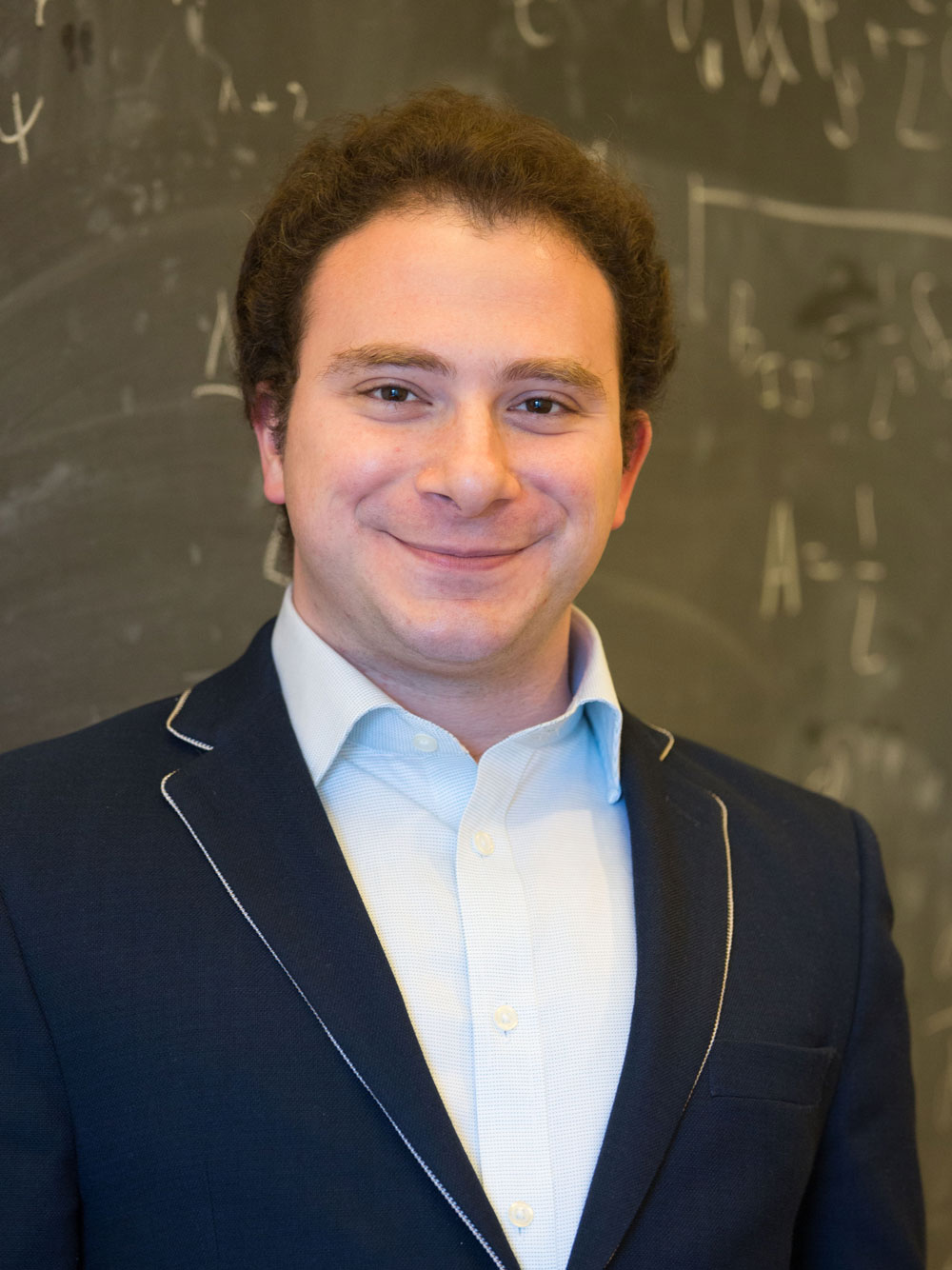
Daniel Jafferis, an associate professor of physics at Harvard University.
Paul Horowitz
Almost everyone believes in unitarity, which means information must escape black holes — but how? In the last five years, some theorists, most notably Joseph Polchinski of the University of California, Santa Barbara, have argued that black holes are empty shells with no interiors at all — that Ellie Arroway, upon hitting a black hole’s event horizon, would fizzle on a “firewall” and radiate out again.
Many theorists believe in black hole interiors (and gentler transitions across their horizons), but in order to understand them, they must discover the fate of information that falls inside. This is critical to building a working quantum theory of gravity, the long-sought union of the quantum and space-time descriptions of nature that comes into sharpest relief in black hole interiors, where extreme gravity acts on a quantum scale.
The quantum gravity connection is what drew Maldacena, and later Jafferis, to the ER = EPR idea, and to wormholes. The implied relationship between tunnels in space-time and quantum entanglement posed by ER = EPR resonated with a popular recent belief that space is essentially stitched into existence by quantum entanglement. It seemed that wormholes had a role to play in stitching together space-time and in letting black hole information worm its way out of black holes — but how might this work? When Jafferis heard Maldacena talk about his cryptic equation and the evidence for it, he was aware that a standard ER wormhole is unstable and non-traversable. But he wondered what Maldacena’s duality would mean for a traversable wormhole like the ones Thorne and others played around with decades ago. Three years after the South Korea talk, Jafferis and his collaborators Gao and Wall presented their answer. The work extends the ER = EPR idea by equating, not a standard wormhole and a pair of entangled particles, but a traversable wormhole and quantum teleportation: a protocol discovered in 1993 that allows a quantum system to disappear and reappear unscathed somewhere else.
When Maldacena read Gao, Jafferis and Wall’s paper, “I viewed it as a really nice idea, one of these ideas that after someone tells you, it’s obvious,” he said. Maldacena and two collaborators, Douglas Stanford and Zhenbin Yang, immediately began exploring the new wormhole’s ramifications for the black hole information paradox; their paper appeared in April. Susskind and Ying Zhao of Stanford followed this with a paper about wormhole teleportation in July. The wormhole “gives an interesting geometric picture for how teleportation happens,” Maldacena said. “The message actually goes through the wormhole.”
Diving Into Wormholes
In their paper, “Diving Into Traversable Wormholes,” published in Fortschritte der Physik, Maldacena, Stanford and Yang consider a wormhole of the new kind that connects two black holes: a parent black hole and a daughter one formed from half of the Hawking radiation given off by the parent as it evaporates. The two systems are as entangled as they can be. Here, the fate of the older black hole’s information is clear: It worms its way out of the daughter black hole.
During an interview this month in his tranquil office at the IAS, Maldacena, a reserved Argentinian-American with a track record of influential insights, described his radical musings. On the right side of a chalk-dusty blackboard, Maldacena drew a faint picture of two black holes connected by the new traversable wormhole. On the left, he sketched a quantum teleportation experiment, performed by the famous fictional experimenters Alice and Bob, who are in possession of entangled quantum particles a and b, respectively. Say Alice wants to teleport a qubit q to Bob. She prepares a combined state of q and a, measures that combined state (reducing it to a pair of classical bits, 1 or 0), and sends the result of this measurement to Bob. He can then use this as a key for operating on b in a way that re-creates the state q. Voila, a unit of quantum information has teleported from one place to the other.
Maldacena turned to the right side of the blackboard. “You can do operations with a pair of black holes that are morally equivalent to what I discussed [about quantum teleportation]. And in that picture, this message really goes through the wormhole.”
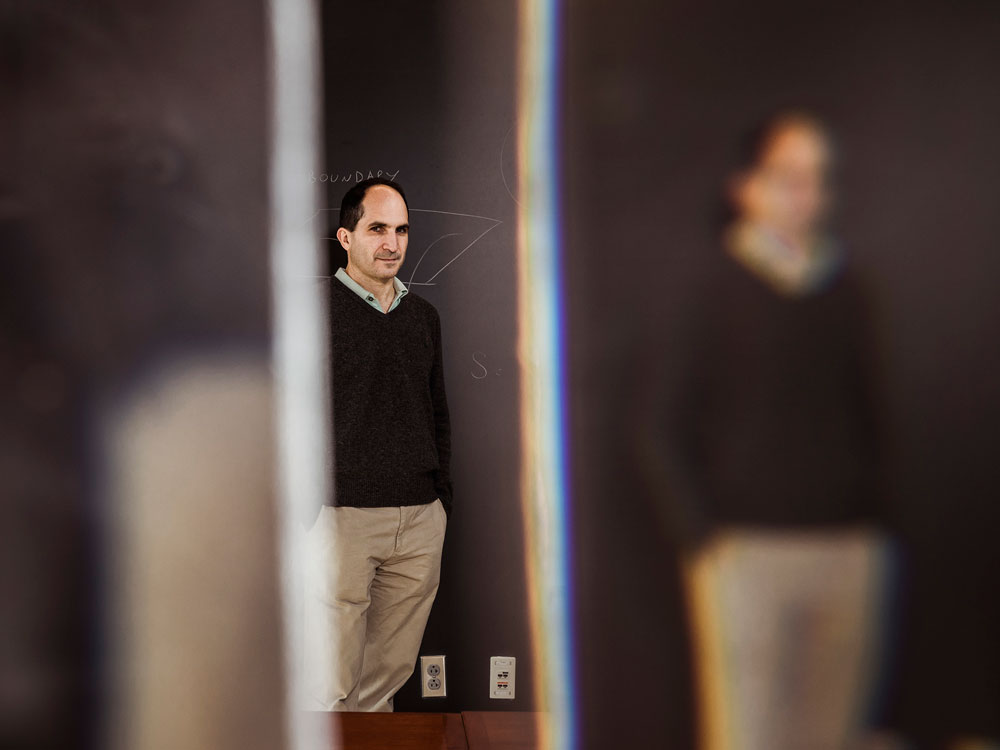
Juan Maldacena, a professor of physics at the Institute for Advanced Study.
Sasha Maslov for Quanta Magazine
Say Alice throws qubit q into black hole A. She then measures a particle of its Hawking radiation, a, and transmits the result of the measurement through the external universe to Bob, who can use this knowledge to operate on b, a Hawking particle coming out of black hole B. Bob’s operation reconstructs q, which appears to pop out of B, a perfect match for the particle that fell into A. This is why some physicists are excited: Gao, Jafferis and Wall’s wormhole allows information to be recovered from black holes. In their paper, they set up their wormhole in a negatively curved space-time geometry that often serves as a useful, if unrealistic, playground for quantum gravity theorists. However, their wormhole idea seems to extend to the real world as long as two black holes are coupled in the right way: “They have to be causally connected and then the nature of the interaction that we took is the simplest thing you can imagine,” Jafferis explained. If you allow the Hawking radiation from one of the black holes to fall into the other, the two black holes become entangled, and the quantum information that falls into one can exit the other.
The quantum-teleportation format precludes using these traversable wormholes as time machines. Anything that goes through the wormhole has to wait for Alice’s message to travel to Bob in the outside universe before it can exit Bob’s black hole, so the wormhole doesn’t offer any superluminal boost that could be exploited for time travel. It seems traversable wormholes might be permitted in nature as long as they offer no speed advantage. “Traversable wormholes are like getting a bank loan,” Gao, Jafferis and Wall wrote in their paper: “You can only get one if you are rich enough not to need it.”
A Naive Octopus
While traversable wormholes won’t revolutionize space travel, according to Preskill the new wormhole discovery provides “a promising resolution” to the black hole firewall question by suggesting that there is no firewall at black hole horizons. Preskill said the discovery rescues “what we call ‘black hole complementarity,’ which means that the interior and exterior of the black hole are not really two different systems but rather two very different, complementary ways of looking at the same system.” If complementarity holds, as is widely assumed, then in passing across a black hole horizon from one realm to the other, Contact’s Ellie Arroway wouldn’t notice anything strange. This seems more likely if, under certain conditions, she could even slide all the way through a Gao-Jafferis-Wall wormhole.
The wormhole also safeguards unitarity — the principle that information is never lost — at least for the entangled black holes being studied. Whatever falls into one black hole eventually exits the other as Hawking radiation, Preskill said, which “can be thought of as in some sense a very scrambled copy of the black hole interior.”
Taking the findings to their logical conclusion, Preskill thinks it ought to be possible (at least for an infinitely advanced civilization) to influence the interior of one of these black holes by manipulating its radiation. This “sounds crazy,” he wrote in an email, but it “might make sense if we can think of the radiation, which is entangled with the black hole — EPR — as being connected to the black hole interior by wormholes — ER. Then tickling the radiation can send a message which can be read from inside the black hole!” He added, “We still have a ways to go, though, before we can flesh out this picture in more detail.”
Indeed, obstacles remain in the quest to generalize the new wormhole findings to a statement about the fate of all quantum information, or the meaning of ER = EPR.

A sketch known as the “octopus” that expresses the ER = EPR idea.
arXiv:1306.0533v2 [hep-th]
In Maldacena and Susskind’s paper proposing ER = EPR, they included a sketch that’s become known as the “octopus”: a black hole with tentacle-like wormholes leading to distant Hawking particles that have evaporated out of it. The authors explained that the sketch illustrates “the entanglement pattern between the black hole and the Hawking radiation. We expect that this entanglement leads to the interior geometry of the black hole.”
But according to Matt Visser, a mathematician and general-relativity expert at Victoria University of Wellington in New Zealand who has studied wormholes since the 1990s, the most literal reading of the octopus picture doesn’t work. The throats of wormholes formed from single Hawking particles would be so thin that qubits could never fit through. “A traversable wormhole throat is ‘transparent’ only to wave packets with size smaller than the throat radius,” Visser explained. “Big wave packets will simply bounce off any small wormhole throat without crossing to the other side.”
Stanford, who co-wrote the recent paper with Maldacena and Yang, acknowledged that this is a problem with the simplest interpretation of the ER = EPR idea, in which each particle of Hawking radiation has its own tentacle-like wormhole. However, a more speculative interpretation of ER = EPR that he and others have in mind does not suffer from this failing. “The idea is that in order to recover the information from the Hawking radiation using this traversable wormhole,” Stanford said, one has to “gather the Hawking radiation together and act on it in a complicated way.” This complicated collective measurement reveals information about the particles that fell in; it has the effect, he said, of “creating a large, traversable wormhole out of the small and unhelpful octopus tentacles. The information would then propagate through this large wormhole.” Maldacena added that, simply put, the theory of quantum gravity might have a new, generalized notion of geometry for which ER equals EPR. “We think quantum gravity should obey this principle,” he said. “We view it more as a guide to the theory.”
In his 1994 popular science book, Black Holes and Time Warps, Kip Thorne celebrated the style of reasoning involved in wormhole research. “No type of thought experiment pushes the laws of physics harder than the type triggered by Carl Sagan’s phone call to me,” he wrote; “thought experiments that ask, ‘What things do the laws of physics permit an infinitely advanced civilization to do, and what things do the laws forbid?’”
This article was reprinted on Wired.com.
